Strategic Human Resource Management Models in the Airline Industry
VerifiedAdded on 2023/06/10
|10
|2274
|382
Report
AI Summary
This report provides a comprehensive analysis of human resource management (HRM) within the airline industry, emphasizing the significance of HRM in this competitive and technology-driven sector. The report explores the application of the Harvard and Michigan models, detailing their features, strengths, and limitations. The Harvard model is presented as particularly suitable for the airline industry, highlighting its focus on stakeholders, HRM policies, outcomes, situational factors, and long-term consequences. The report also acknowledges the use of other models, such as the Resource-Based View, by airlines like British Airways, and discusses how these models are tailored to meet specific organizational needs. Through an examination of these models, the report underscores the crucial role of HRM in achieving organizational objectives, enhancing customer satisfaction, and ensuring the overall success of the airline industry. The analysis incorporates various aspects, including employee management, reward systems, and strategic alignment, to provide a holistic understanding of HRM practices in this dynamic sector. The report concludes by summarizing the key takeaways and the importance of HRM in the airline industry.
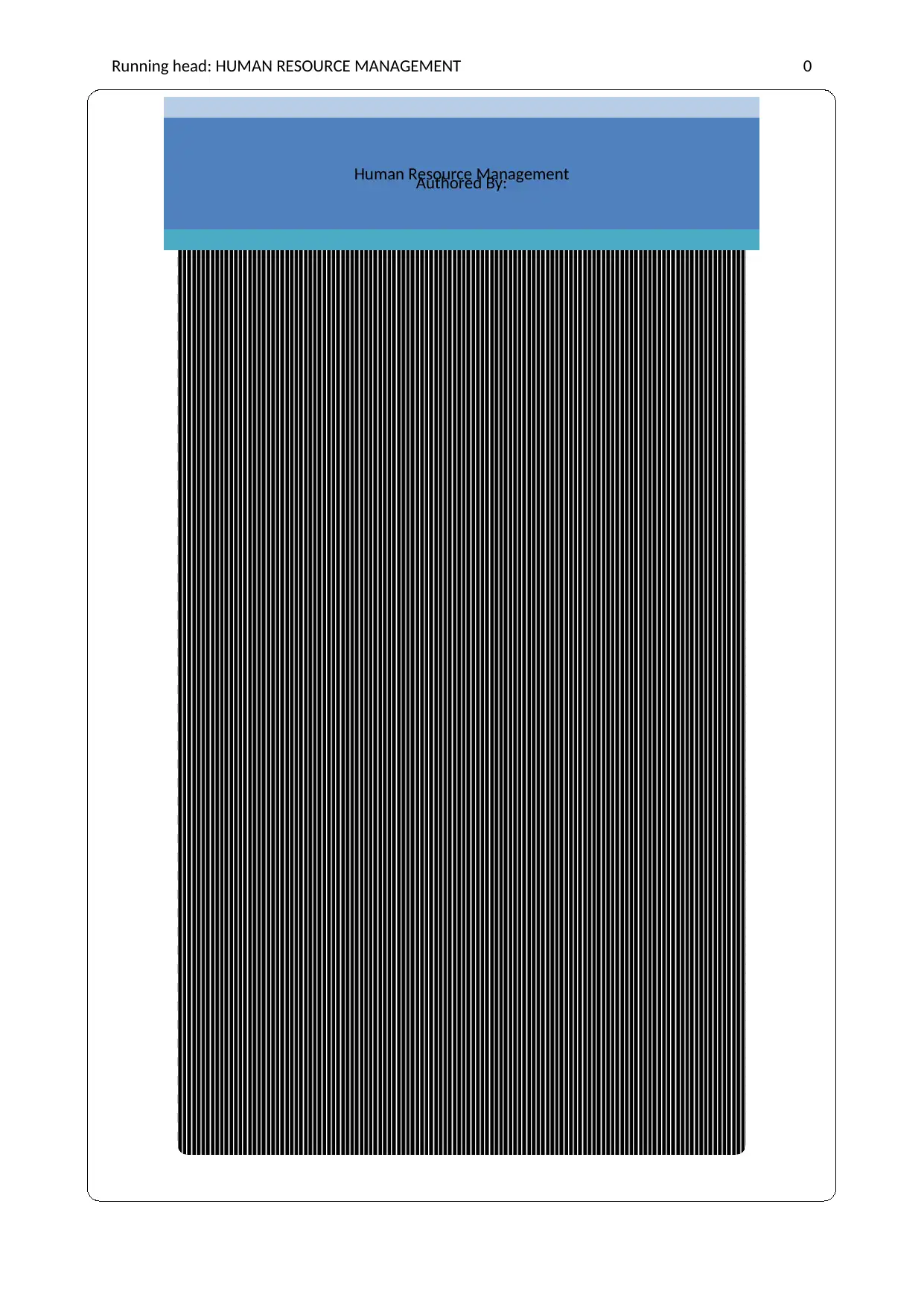
Running head: HUMAN RESOURCE MANAGEMENT 0
Human Resource Management
Authored By:
Human Resource Management
Authored By:
Paraphrase This Document
Need a fresh take? Get an instant paraphrase of this document with our AI Paraphraser
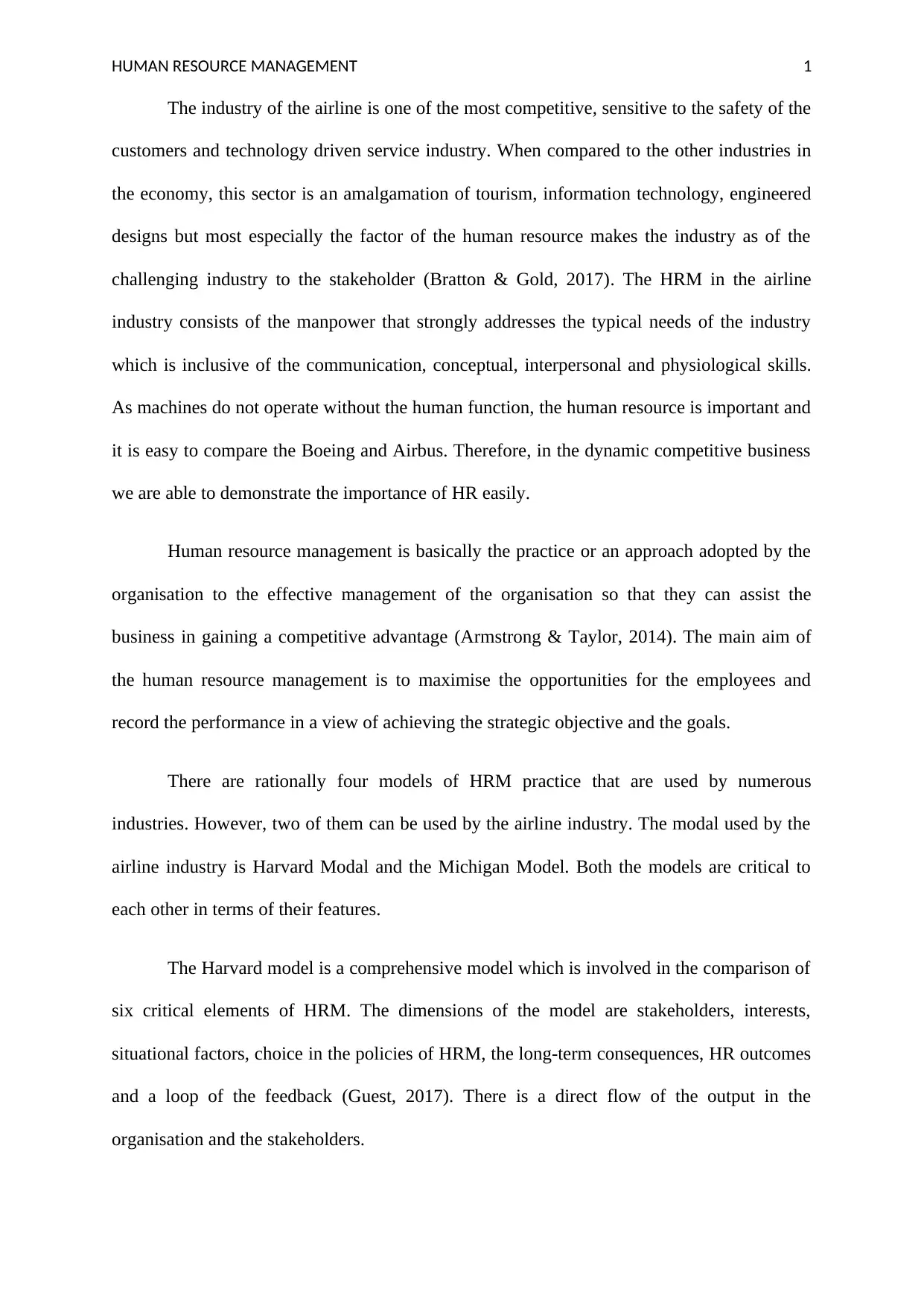
HUMAN RESOURCE MANAGEMENT 1
The industry of the airline is one of the most competitive, sensitive to the safety of the
customers and technology driven service industry. When compared to the other industries in
the economy, this sector is an amalgamation of tourism, information technology, engineered
designs but most especially the factor of the human resource makes the industry as of the
challenging industry to the stakeholder (Bratton & Gold, 2017). The HRM in the airline
industry consists of the manpower that strongly addresses the typical needs of the industry
which is inclusive of the communication, conceptual, interpersonal and physiological skills.
As machines do not operate without the human function, the human resource is important and
it is easy to compare the Boeing and Airbus. Therefore, in the dynamic competitive business
we are able to demonstrate the importance of HR easily.
Human resource management is basically the practice or an approach adopted by the
organisation to the effective management of the organisation so that they can assist the
business in gaining a competitive advantage (Armstrong & Taylor, 2014). The main aim of
the human resource management is to maximise the opportunities for the employees and
record the performance in a view of achieving the strategic objective and the goals.
There are rationally four models of HRM practice that are used by numerous
industries. However, two of them can be used by the airline industry. The modal used by the
airline industry is Harvard Modal and the Michigan Model. Both the models are critical to
each other in terms of their features.
The Harvard model is a comprehensive model which is involved in the comparison of
six critical elements of HRM. The dimensions of the model are stakeholders, interests,
situational factors, choice in the policies of HRM, the long-term consequences, HR outcomes
and a loop of the feedback (Guest, 2017). There is a direct flow of the output in the
organisation and the stakeholders.
The industry of the airline is one of the most competitive, sensitive to the safety of the
customers and technology driven service industry. When compared to the other industries in
the economy, this sector is an amalgamation of tourism, information technology, engineered
designs but most especially the factor of the human resource makes the industry as of the
challenging industry to the stakeholder (Bratton & Gold, 2017). The HRM in the airline
industry consists of the manpower that strongly addresses the typical needs of the industry
which is inclusive of the communication, conceptual, interpersonal and physiological skills.
As machines do not operate without the human function, the human resource is important and
it is easy to compare the Boeing and Airbus. Therefore, in the dynamic competitive business
we are able to demonstrate the importance of HR easily.
Human resource management is basically the practice or an approach adopted by the
organisation to the effective management of the organisation so that they can assist the
business in gaining a competitive advantage (Armstrong & Taylor, 2014). The main aim of
the human resource management is to maximise the opportunities for the employees and
record the performance in a view of achieving the strategic objective and the goals.
There are rationally four models of HRM practice that are used by numerous
industries. However, two of them can be used by the airline industry. The modal used by the
airline industry is Harvard Modal and the Michigan Model. Both the models are critical to
each other in terms of their features.
The Harvard model is a comprehensive model which is involved in the comparison of
six critical elements of HRM. The dimensions of the model are stakeholders, interests,
situational factors, choice in the policies of HRM, the long-term consequences, HR outcomes
and a loop of the feedback (Guest, 2017). There is a direct flow of the output in the
organisation and the stakeholders.
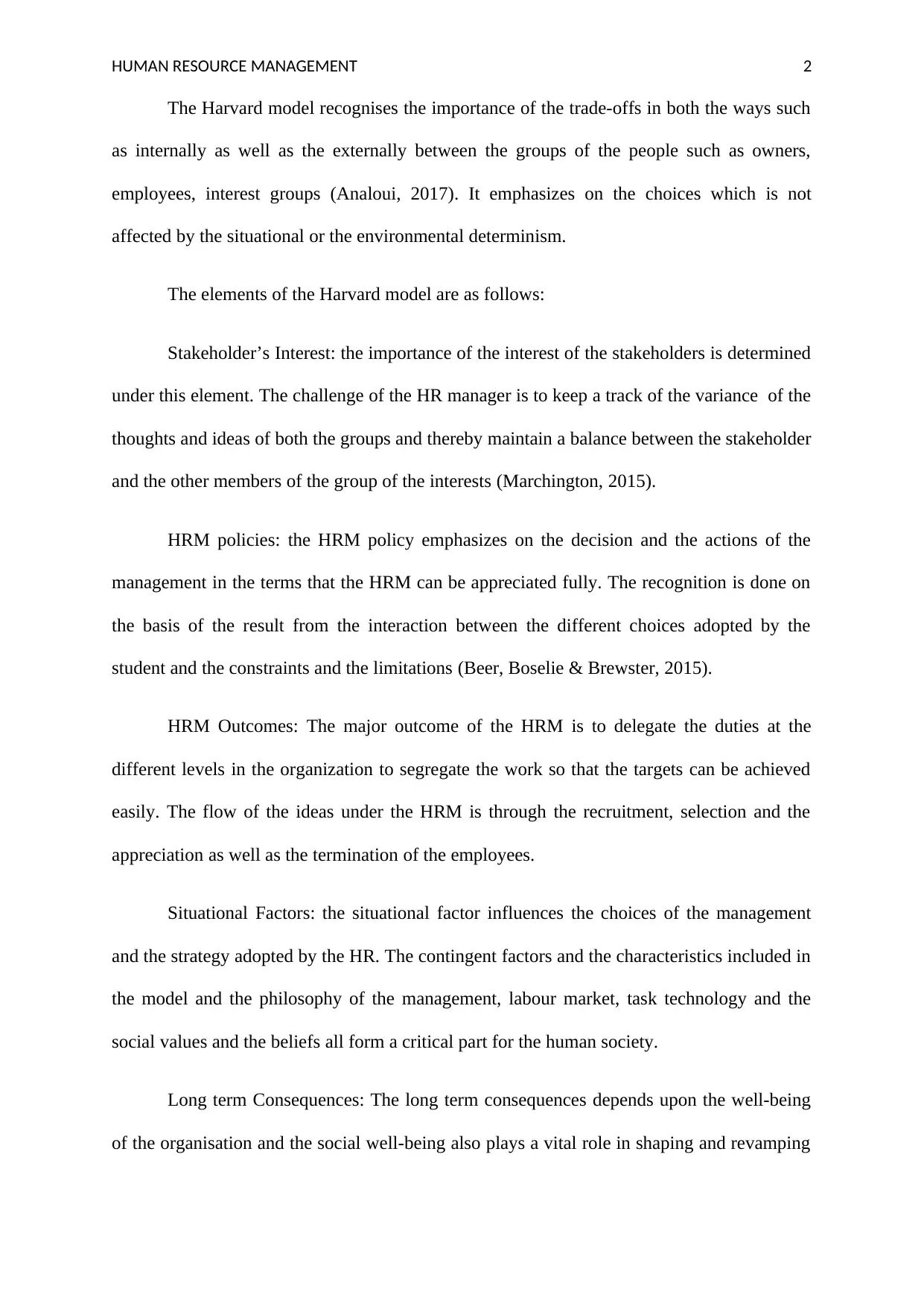
HUMAN RESOURCE MANAGEMENT 2
The Harvard model recognises the importance of the trade-offs in both the ways such
as internally as well as the externally between the groups of the people such as owners,
employees, interest groups (Analoui, 2017). It emphasizes on the choices which is not
affected by the situational or the environmental determinism.
The elements of the Harvard model are as follows:
Stakeholder’s Interest: the importance of the interest of the stakeholders is determined
under this element. The challenge of the HR manager is to keep a track of the variance of the
thoughts and ideas of both the groups and thereby maintain a balance between the stakeholder
and the other members of the group of the interests (Marchington, 2015).
HRM policies: the HRM policy emphasizes on the decision and the actions of the
management in the terms that the HRM can be appreciated fully. The recognition is done on
the basis of the result from the interaction between the different choices adopted by the
student and the constraints and the limitations (Beer, Boselie & Brewster, 2015).
HRM Outcomes: The major outcome of the HRM is to delegate the duties at the
different levels in the organization to segregate the work so that the targets can be achieved
easily. The flow of the ideas under the HRM is through the recruitment, selection and the
appreciation as well as the termination of the employees.
Situational Factors: the situational factor influences the choices of the management
and the strategy adopted by the HR. The contingent factors and the characteristics included in
the model and the philosophy of the management, labour market, task technology and the
social values and the beliefs all form a critical part for the human society.
Long term Consequences: The long term consequences depends upon the well-being
of the organisation and the social well-being also plays a vital role in shaping and revamping
The Harvard model recognises the importance of the trade-offs in both the ways such
as internally as well as the externally between the groups of the people such as owners,
employees, interest groups (Analoui, 2017). It emphasizes on the choices which is not
affected by the situational or the environmental determinism.
The elements of the Harvard model are as follows:
Stakeholder’s Interest: the importance of the interest of the stakeholders is determined
under this element. The challenge of the HR manager is to keep a track of the variance of the
thoughts and ideas of both the groups and thereby maintain a balance between the stakeholder
and the other members of the group of the interests (Marchington, 2015).
HRM policies: the HRM policy emphasizes on the decision and the actions of the
management in the terms that the HRM can be appreciated fully. The recognition is done on
the basis of the result from the interaction between the different choices adopted by the
student and the constraints and the limitations (Beer, Boselie & Brewster, 2015).
HRM Outcomes: The major outcome of the HRM is to delegate the duties at the
different levels in the organization to segregate the work so that the targets can be achieved
easily. The flow of the ideas under the HRM is through the recruitment, selection and the
appreciation as well as the termination of the employees.
Situational Factors: the situational factor influences the choices of the management
and the strategy adopted by the HR. The contingent factors and the characteristics included in
the model and the philosophy of the management, labour market, task technology and the
social values and the beliefs all form a critical part for the human society.
Long term Consequences: The long term consequences depends upon the well-being
of the organisation and the social well-being also plays a vital role in shaping and revamping
⊘ This is a preview!⊘
Do you want full access?
Subscribe today to unlock all pages.

Trusted by 1+ million students worldwide
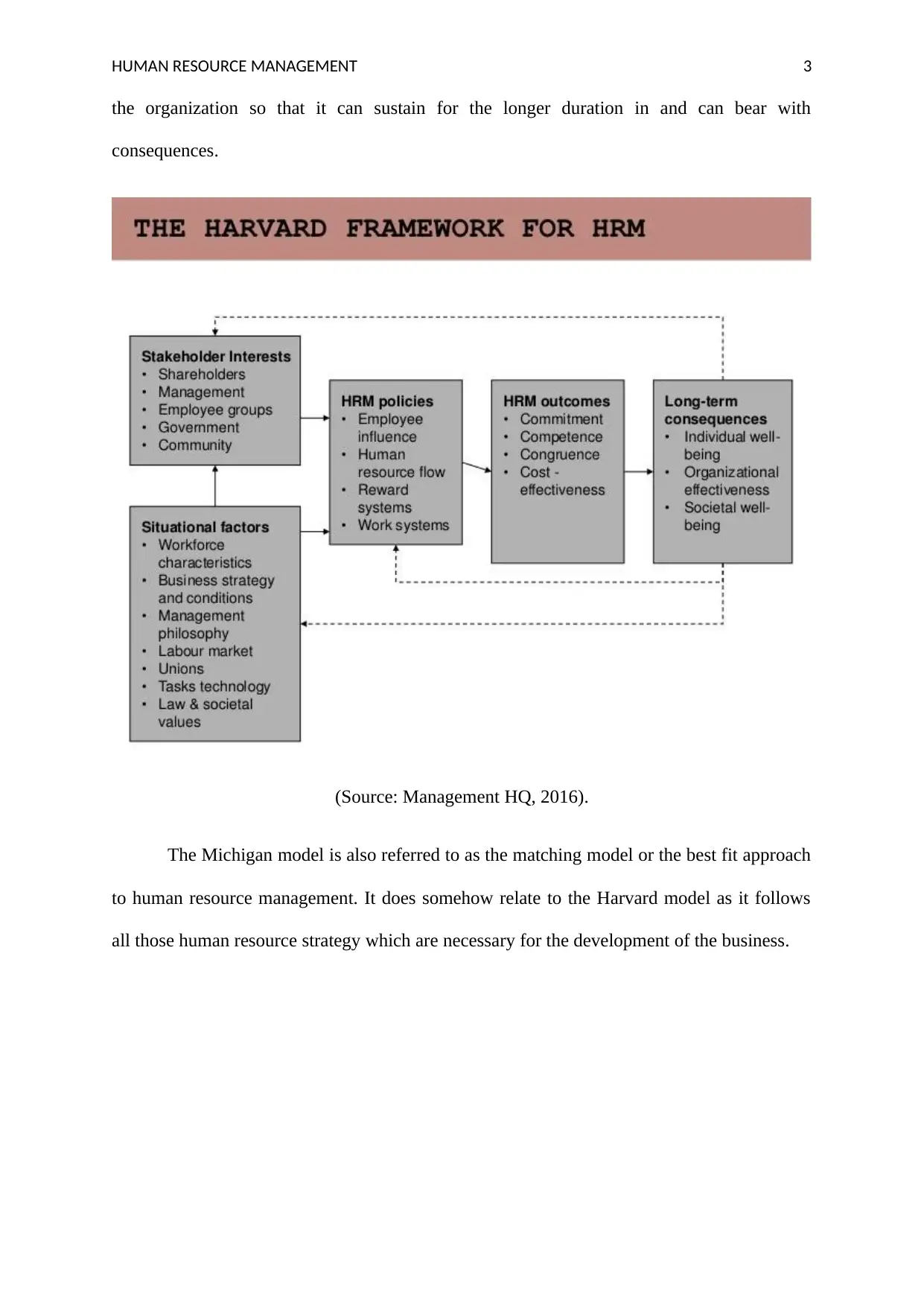
HUMAN RESOURCE MANAGEMENT 3
the organization so that it can sustain for the longer duration in and can bear with
consequences.
(Source: Management HQ, 2016).
The Michigan model is also referred to as the matching model or the best fit approach
to human resource management. It does somehow relate to the Harvard model as it follows
all those human resource strategy which are necessary for the development of the business.
the organization so that it can sustain for the longer duration in and can bear with
consequences.
(Source: Management HQ, 2016).
The Michigan model is also referred to as the matching model or the best fit approach
to human resource management. It does somehow relate to the Harvard model as it follows
all those human resource strategy which are necessary for the development of the business.
Paraphrase This Document
Need a fresh take? Get an instant paraphrase of this document with our AI Paraphraser
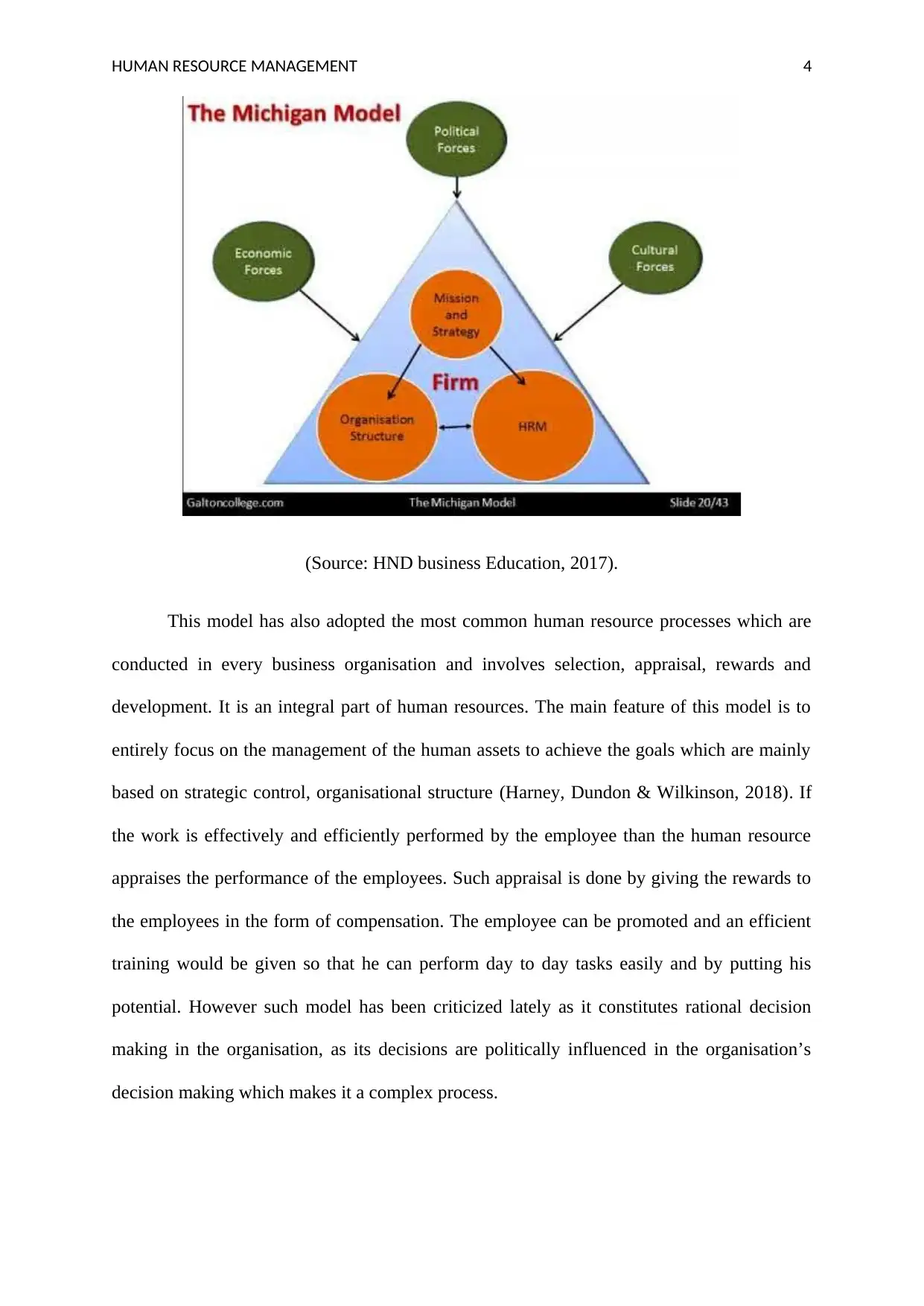
HUMAN RESOURCE MANAGEMENT 4
(Source: HND business Education, 2017).
This model has also adopted the most common human resource processes which are
conducted in every business organisation and involves selection, appraisal, rewards and
development. It is an integral part of human resources. The main feature of this model is to
entirely focus on the management of the human assets to achieve the goals which are mainly
based on strategic control, organisational structure (Harney, Dundon & Wilkinson, 2018). If
the work is effectively and efficiently performed by the employee than the human resource
appraises the performance of the employees. Such appraisal is done by giving the rewards to
the employees in the form of compensation. The employee can be promoted and an efficient
training would be given so that he can perform day to day tasks easily and by putting his
potential. However such model has been criticized lately as it constitutes rational decision
making in the organisation, as its decisions are politically influenced in the organisation’s
decision making which makes it a complex process.
(Source: HND business Education, 2017).
This model has also adopted the most common human resource processes which are
conducted in every business organisation and involves selection, appraisal, rewards and
development. It is an integral part of human resources. The main feature of this model is to
entirely focus on the management of the human assets to achieve the goals which are mainly
based on strategic control, organisational structure (Harney, Dundon & Wilkinson, 2018). If
the work is effectively and efficiently performed by the employee than the human resource
appraises the performance of the employees. Such appraisal is done by giving the rewards to
the employees in the form of compensation. The employee can be promoted and an efficient
training would be given so that he can perform day to day tasks easily and by putting his
potential. However such model has been criticized lately as it constitutes rational decision
making in the organisation, as its decisions are politically influenced in the organisation’s
decision making which makes it a complex process.
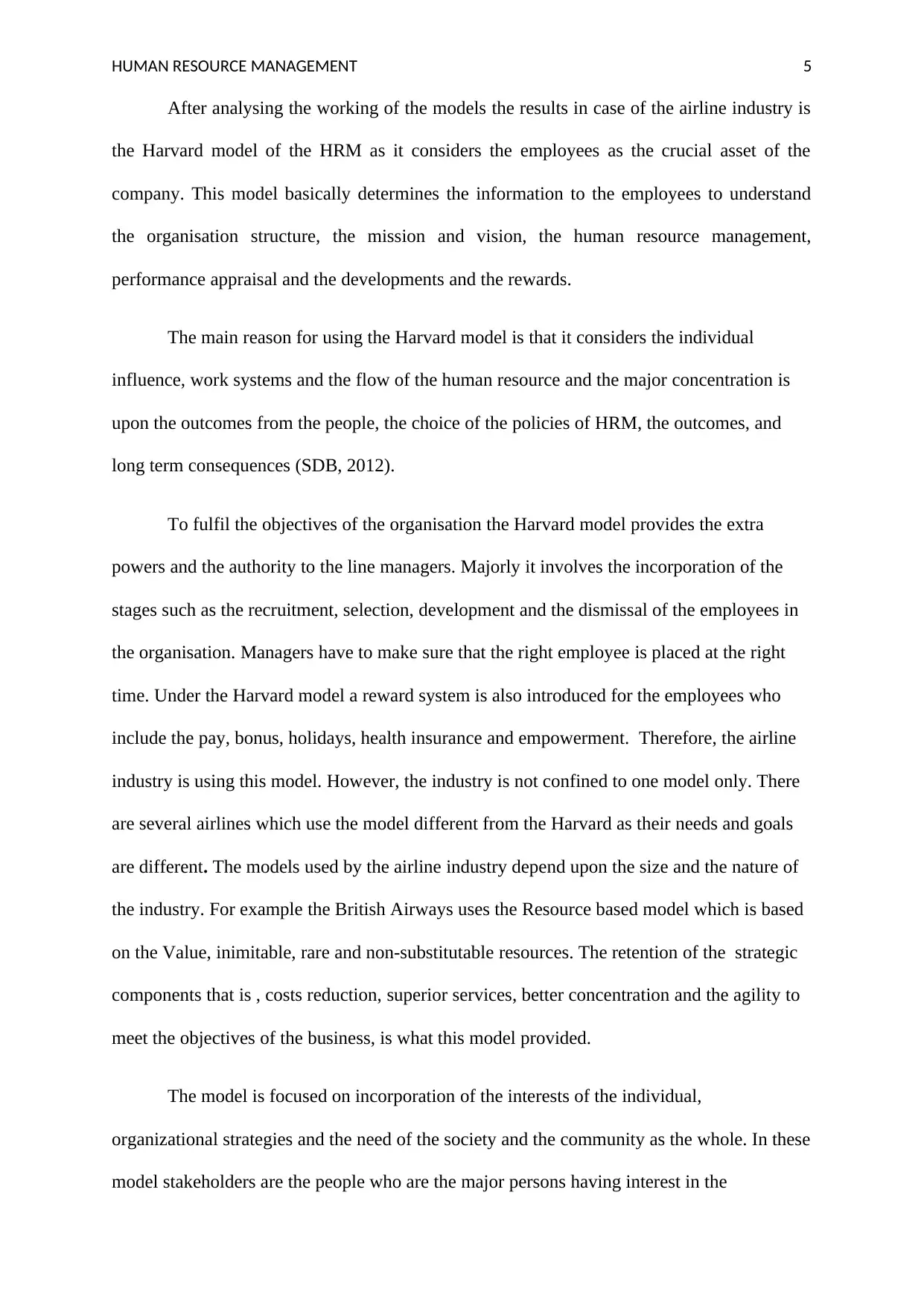
HUMAN RESOURCE MANAGEMENT 5
After analysing the working of the models the results in case of the airline industry is
the Harvard model of the HRM as it considers the employees as the crucial asset of the
company. This model basically determines the information to the employees to understand
the organisation structure, the mission and vision, the human resource management,
performance appraisal and the developments and the rewards.
The main reason for using the Harvard model is that it considers the individual
influence, work systems and the flow of the human resource and the major concentration is
upon the outcomes from the people, the choice of the policies of HRM, the outcomes, and
long term consequences (SDB, 2012).
To fulfil the objectives of the organisation the Harvard model provides the extra
powers and the authority to the line managers. Majorly it involves the incorporation of the
stages such as the recruitment, selection, development and the dismissal of the employees in
the organisation. Managers have to make sure that the right employee is placed at the right
time. Under the Harvard model a reward system is also introduced for the employees who
include the pay, bonus, holidays, health insurance and empowerment. Therefore, the airline
industry is using this model. However, the industry is not confined to one model only. There
are several airlines which use the model different from the Harvard as their needs and goals
are different. The models used by the airline industry depend upon the size and the nature of
the industry. For example the British Airways uses the Resource based model which is based
on the Value, inimitable, rare and non-substitutable resources. The retention of the strategic
components that is , costs reduction, superior services, better concentration and the agility to
meet the objectives of the business, is what this model provided.
The model is focused on incorporation of the interests of the individual,
organizational strategies and the need of the society and the community as the whole. In these
model stakeholders are the people who are the major persons having interest in the
After analysing the working of the models the results in case of the airline industry is
the Harvard model of the HRM as it considers the employees as the crucial asset of the
company. This model basically determines the information to the employees to understand
the organisation structure, the mission and vision, the human resource management,
performance appraisal and the developments and the rewards.
The main reason for using the Harvard model is that it considers the individual
influence, work systems and the flow of the human resource and the major concentration is
upon the outcomes from the people, the choice of the policies of HRM, the outcomes, and
long term consequences (SDB, 2012).
To fulfil the objectives of the organisation the Harvard model provides the extra
powers and the authority to the line managers. Majorly it involves the incorporation of the
stages such as the recruitment, selection, development and the dismissal of the employees in
the organisation. Managers have to make sure that the right employee is placed at the right
time. Under the Harvard model a reward system is also introduced for the employees who
include the pay, bonus, holidays, health insurance and empowerment. Therefore, the airline
industry is using this model. However, the industry is not confined to one model only. There
are several airlines which use the model different from the Harvard as their needs and goals
are different. The models used by the airline industry depend upon the size and the nature of
the industry. For example the British Airways uses the Resource based model which is based
on the Value, inimitable, rare and non-substitutable resources. The retention of the strategic
components that is , costs reduction, superior services, better concentration and the agility to
meet the objectives of the business, is what this model provided.
The model is focused on incorporation of the interests of the individual,
organizational strategies and the need of the society and the community as the whole. In these
model stakeholders are the people who are the major persons having interest in the
⊘ This is a preview!⊘
Do you want full access?
Subscribe today to unlock all pages.

Trusted by 1+ million students worldwide
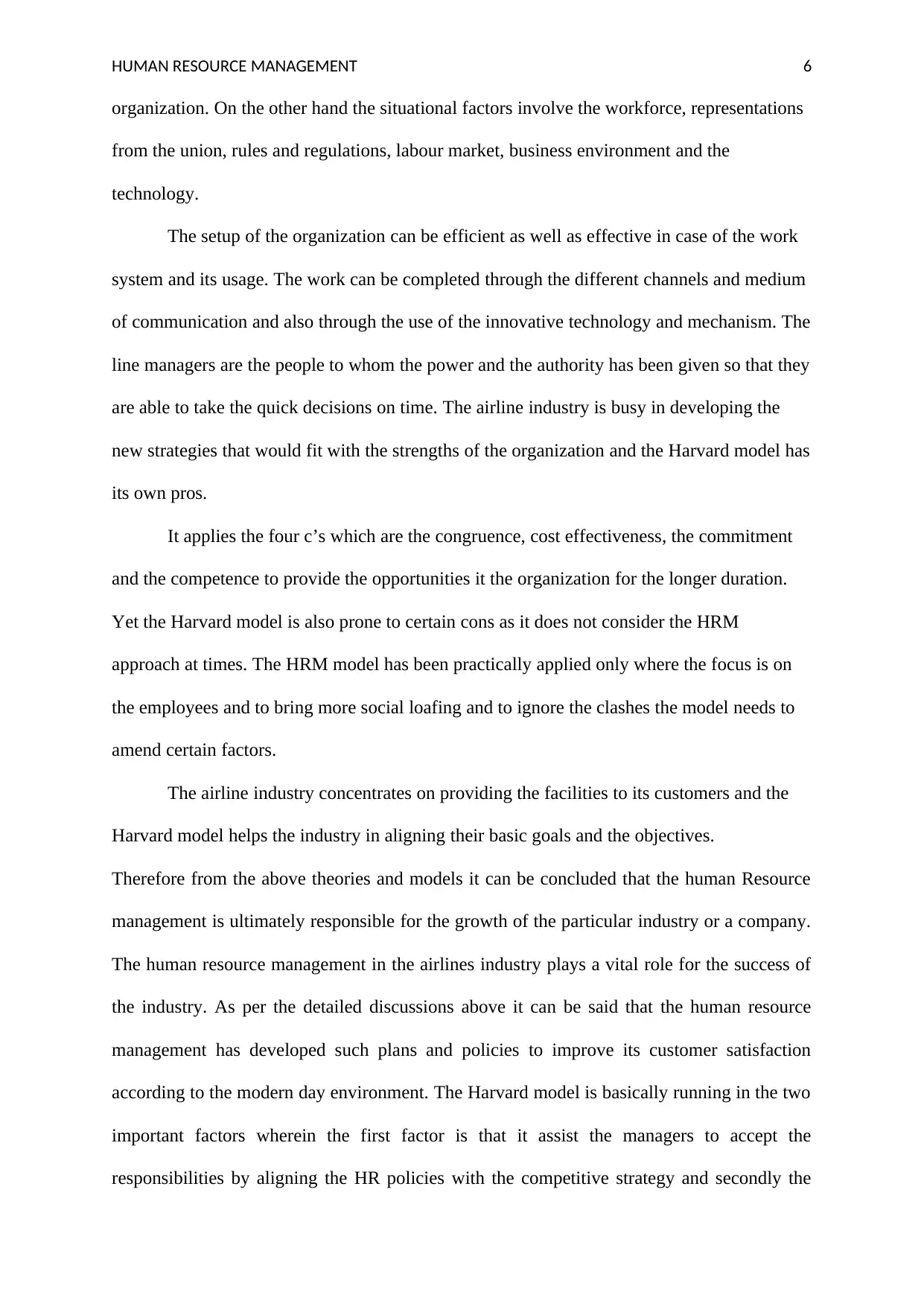
HUMAN RESOURCE MANAGEMENT 6
organization. On the other hand the situational factors involve the workforce, representations
from the union, rules and regulations, labour market, business environment and the
technology.
The setup of the organization can be efficient as well as effective in case of the work
system and its usage. The work can be completed through the different channels and medium
of communication and also through the use of the innovative technology and mechanism. The
line managers are the people to whom the power and the authority has been given so that they
are able to take the quick decisions on time. The airline industry is busy in developing the
new strategies that would fit with the strengths of the organization and the Harvard model has
its own pros.
It applies the four c’s which are the congruence, cost effectiveness, the commitment
and the competence to provide the opportunities it the organization for the longer duration.
Yet the Harvard model is also prone to certain cons as it does not consider the HRM
approach at times. The HRM model has been practically applied only where the focus is on
the employees and to bring more social loafing and to ignore the clashes the model needs to
amend certain factors.
The airline industry concentrates on providing the facilities to its customers and the
Harvard model helps the industry in aligning their basic goals and the objectives.
Therefore from the above theories and models it can be concluded that the human Resource
management is ultimately responsible for the growth of the particular industry or a company.
The human resource management in the airlines industry plays a vital role for the success of
the industry. As per the detailed discussions above it can be said that the human resource
management has developed such plans and policies to improve its customer satisfaction
according to the modern day environment. The Harvard model is basically running in the two
important factors wherein the first factor is that it assist the managers to accept the
responsibilities by aligning the HR policies with the competitive strategy and secondly the
organization. On the other hand the situational factors involve the workforce, representations
from the union, rules and regulations, labour market, business environment and the
technology.
The setup of the organization can be efficient as well as effective in case of the work
system and its usage. The work can be completed through the different channels and medium
of communication and also through the use of the innovative technology and mechanism. The
line managers are the people to whom the power and the authority has been given so that they
are able to take the quick decisions on time. The airline industry is busy in developing the
new strategies that would fit with the strengths of the organization and the Harvard model has
its own pros.
It applies the four c’s which are the congruence, cost effectiveness, the commitment
and the competence to provide the opportunities it the organization for the longer duration.
Yet the Harvard model is also prone to certain cons as it does not consider the HRM
approach at times. The HRM model has been practically applied only where the focus is on
the employees and to bring more social loafing and to ignore the clashes the model needs to
amend certain factors.
The airline industry concentrates on providing the facilities to its customers and the
Harvard model helps the industry in aligning their basic goals and the objectives.
Therefore from the above theories and models it can be concluded that the human Resource
management is ultimately responsible for the growth of the particular industry or a company.
The human resource management in the airlines industry plays a vital role for the success of
the industry. As per the detailed discussions above it can be said that the human resource
management has developed such plans and policies to improve its customer satisfaction
according to the modern day environment. The Harvard model is basically running in the two
important factors wherein the first factor is that it assist the managers to accept the
responsibilities by aligning the HR policies with the competitive strategy and secondly the
Paraphrase This Document
Need a fresh take? Get an instant paraphrase of this document with our AI Paraphraser
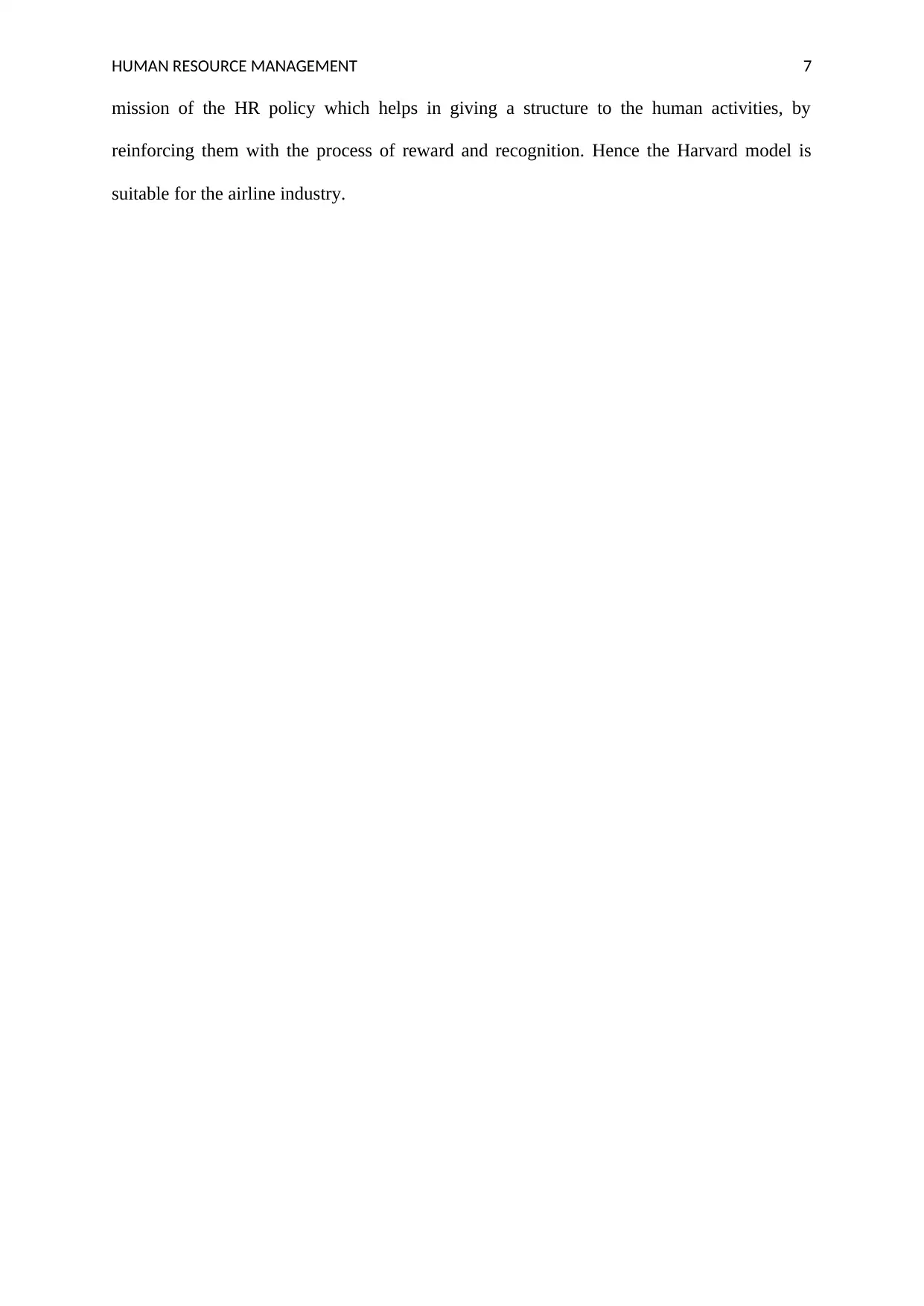
HUMAN RESOURCE MANAGEMENT 7
mission of the HR policy which helps in giving a structure to the human activities, by
reinforcing them with the process of reward and recognition. Hence the Harvard model is
suitable for the airline industry.
mission of the HR policy which helps in giving a structure to the human activities, by
reinforcing them with the process of reward and recognition. Hence the Harvard model is
suitable for the airline industry.
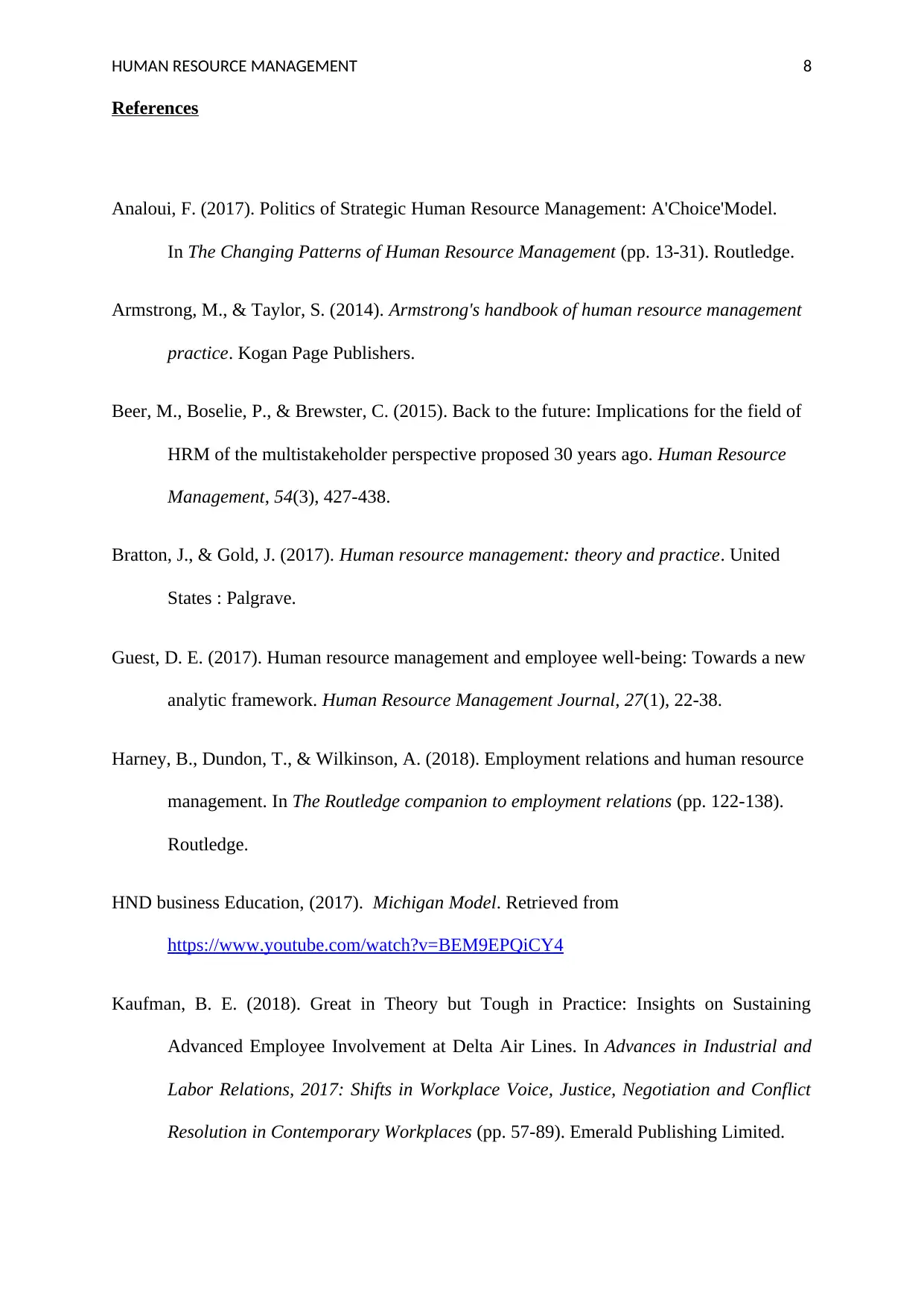
HUMAN RESOURCE MANAGEMENT 8
References
Analoui, F. (2017). Politics of Strategic Human Resource Management: A'Choice'Model.
In The Changing Patterns of Human Resource Management (pp. 13-31). Routledge.
Armstrong, M., & Taylor, S. (2014). Armstrong's handbook of human resource management
practice. Kogan Page Publishers.
Beer, M., Boselie, P., & Brewster, C. (2015). Back to the future: Implications for the field of
HRM of the multistakeholder perspective proposed 30 years ago. Human Resource
Management, 54(3), 427-438.
Bratton, J., & Gold, J. (2017). Human resource management: theory and practice. United
States : Palgrave.
Guest, D. E. (2017). Human resource management and employee well‐being: Towards a new
analytic framework. Human Resource Management Journal, 27(1), 22-38.
Harney, B., Dundon, T., & Wilkinson, A. (2018). Employment relations and human resource
management. In The Routledge companion to employment relations (pp. 122-138).
Routledge.
HND business Education, (2017). Michigan Model. Retrieved from
https://www.youtube.com/watch?v=BEM9EPQiCY4
Kaufman, B. E. (2018). Great in Theory but Tough in Practice: Insights on Sustaining
Advanced Employee Involvement at Delta Air Lines. In Advances in Industrial and
Labor Relations, 2017: Shifts in Workplace Voice, Justice, Negotiation and Conflict
Resolution in Contemporary Workplaces (pp. 57-89). Emerald Publishing Limited.
References
Analoui, F. (2017). Politics of Strategic Human Resource Management: A'Choice'Model.
In The Changing Patterns of Human Resource Management (pp. 13-31). Routledge.
Armstrong, M., & Taylor, S. (2014). Armstrong's handbook of human resource management
practice. Kogan Page Publishers.
Beer, M., Boselie, P., & Brewster, C. (2015). Back to the future: Implications for the field of
HRM of the multistakeholder perspective proposed 30 years ago. Human Resource
Management, 54(3), 427-438.
Bratton, J., & Gold, J. (2017). Human resource management: theory and practice. United
States : Palgrave.
Guest, D. E. (2017). Human resource management and employee well‐being: Towards a new
analytic framework. Human Resource Management Journal, 27(1), 22-38.
Harney, B., Dundon, T., & Wilkinson, A. (2018). Employment relations and human resource
management. In The Routledge companion to employment relations (pp. 122-138).
Routledge.
HND business Education, (2017). Michigan Model. Retrieved from
https://www.youtube.com/watch?v=BEM9EPQiCY4
Kaufman, B. E. (2018). Great in Theory but Tough in Practice: Insights on Sustaining
Advanced Employee Involvement at Delta Air Lines. In Advances in Industrial and
Labor Relations, 2017: Shifts in Workplace Voice, Justice, Negotiation and Conflict
Resolution in Contemporary Workplaces (pp. 57-89). Emerald Publishing Limited.
⊘ This is a preview!⊘
Do you want full access?
Subscribe today to unlock all pages.

Trusted by 1+ million students worldwide
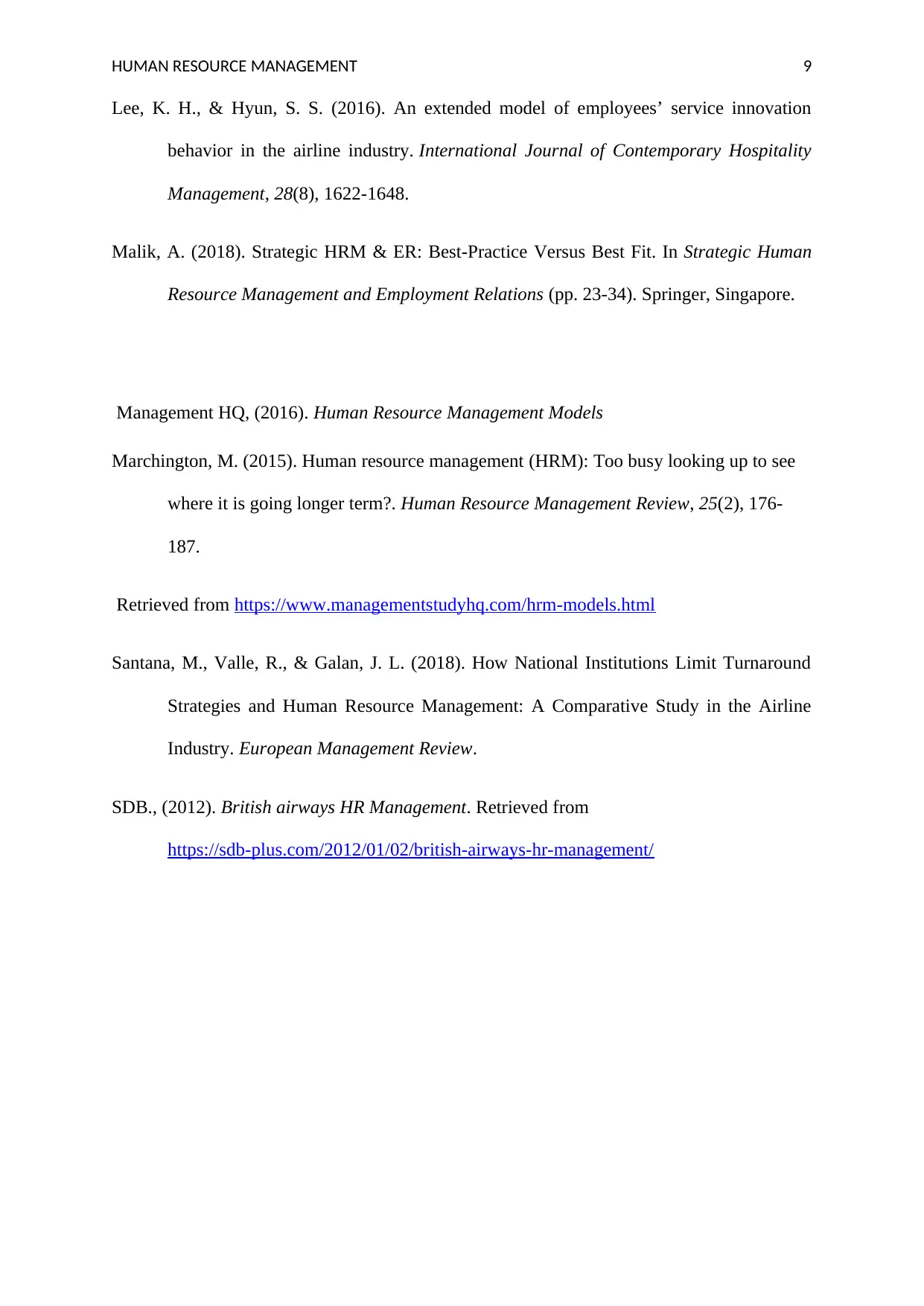
HUMAN RESOURCE MANAGEMENT 9
Lee, K. H., & Hyun, S. S. (2016). An extended model of employees’ service innovation
behavior in the airline industry. International Journal of Contemporary Hospitality
Management, 28(8), 1622-1648.
Malik, A. (2018). Strategic HRM & ER: Best-Practice Versus Best Fit. In Strategic Human
Resource Management and Employment Relations (pp. 23-34). Springer, Singapore.
Management HQ, (2016). Human Resource Management Models
Marchington, M. (2015). Human resource management (HRM): Too busy looking up to see
where it is going longer term?. Human Resource Management Review, 25(2), 176-
187.
Retrieved from https://www.managementstudyhq.com/hrm-models.html
Santana, M., Valle, R., & Galan, J. L. (2018). How National Institutions Limit Turnaround
Strategies and Human Resource Management: A Comparative Study in the Airline
Industry. European Management Review.
SDB., (2012). British airways HR Management. Retrieved from
https://sdb-plus.com/2012/01/02/british-airways-hr-management/
Lee, K. H., & Hyun, S. S. (2016). An extended model of employees’ service innovation
behavior in the airline industry. International Journal of Contemporary Hospitality
Management, 28(8), 1622-1648.
Malik, A. (2018). Strategic HRM & ER: Best-Practice Versus Best Fit. In Strategic Human
Resource Management and Employment Relations (pp. 23-34). Springer, Singapore.
Management HQ, (2016). Human Resource Management Models
Marchington, M. (2015). Human resource management (HRM): Too busy looking up to see
where it is going longer term?. Human Resource Management Review, 25(2), 176-
187.
Retrieved from https://www.managementstudyhq.com/hrm-models.html
Santana, M., Valle, R., & Galan, J. L. (2018). How National Institutions Limit Turnaround
Strategies and Human Resource Management: A Comparative Study in the Airline
Industry. European Management Review.
SDB., (2012). British airways HR Management. Retrieved from
https://sdb-plus.com/2012/01/02/british-airways-hr-management/
1 out of 10
Related Documents
Your All-in-One AI-Powered Toolkit for Academic Success.
+13062052269
info@desklib.com
Available 24*7 on WhatsApp / Email
![[object Object]](/_next/static/media/star-bottom.7253800d.svg)
Unlock your academic potential
Copyright © 2020–2025 A2Z Services. All Rights Reserved. Developed and managed by ZUCOL.





